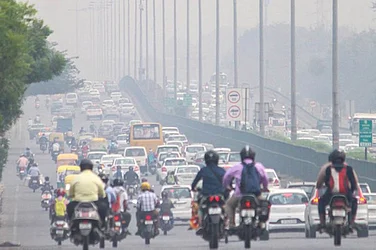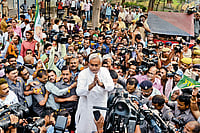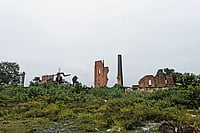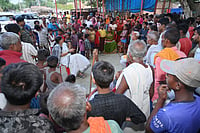In the narrow lanes of Sasaram town in Rohtas district of Bihar, flags are fluttering on a humid May evening outside residences. Some are saffron; some are green, giving a sense of co-existence.
To an outsider visiting the town, this may come as a surprise because just last year in March, a clash broke out between two groups in Sasaram after the Ram Navami procession. Multiple stone-pelting incidents were reported, and the authorities had to impose prohibitory orders under Section 144 to maintain the law and order situation. The town remained on edge even a few days later when two blasts injured a couple of people. More than 150 people from both communities were arrested. The violence divided a part of the town.
“In the newly-developed areas, you will now find separate localities for Hindus and Muslims, but in old Sasaram, families continue to live peacefully,” says Qazi Saliq Hasan, a social activist who lives in Mohalla Shahjuma. “In fact, after last year’s violence, we decided to celebrate all the festivals together and made sure it happened,” he adds.
Ratan Shah, who runs a grocery shop and lives next to a Muslim family in Paatan Gali, says: “Both communities were very disturbed after the riots but nothing changed between us. We blame the outsiders for the violence.”
Sabban Khatoon, a resident of Shah Jalal Peer area, still remembers the day her house was ransacked. “They broke the door, the electric meter and looted our jewellery. All of us feel they were outsiders. We don’t recognise any of them,” she says.
For those who lost something, erasing the bitter memories has been difficult.
Raj Kumar, who lives next to a Muslim family in the Shah Jalal Peer area, was not home that day. “The rioters fled with my cow and five goats. My wife had to hide in another room. Who were they? Why did they attack my house? It wasn’t personal, it seems like we were targeted,” he says.
Among those arrested was Shivnath Chaudhary, a local BJP leader. Recalling the time he spent in jail, he says: “I met many Muslims there. We would talk to each other. We all reached the conclusion that anti-social elements from both communities were responsible.”
He adds: “There were very few policemen guarding the procession last year. This year, both Ram Navami and Muharram were peaceful.”
While he blamed the police for the violence, the People’s Union for Civil Liberties (PUCL), a human rights body, said in its fact-finding report that the Sasaram violence was planned and had started with an attack on a masjid and a mazaar the day before the Ram Navami procession.
The residents say they have put the violence behind and are glad it has had no impact on Hindu-Muslim unity, but historians say the two communities have lived in harmony for generations and the credit goes to Sher Shah Suri. Sasaram was the capital of the Sur dynasty during Suri’s rule in the 16th century and he always worked on Hindi-Muslim unity. Today, the population of Sasaram is around 3.58 lakh and Muslims form 25 per cent of the population. The city falls under the Scheduled Caste (SC) reserved Sasaram Lok Sabha seat. The BJP won this seat in the 2014 and 2019 General Elections.
***
Last year, instances of communal violence were reported during Ram Navami from other districts as well. But in some of these districts, unlike in Sasaram, the disenchantment with the other community was still visible to some extent.
In Bihar Sharif town of Nalanda district, a mosque was attacked and a century-old library located in a historic Madrasa was burnt. The violence killed a youth and more than a dozen shops were ransacked, looted, and burnt.
Naushad Alam and Umesh Prasad Goswami, two among dozens of shopkeepers affected in last year’s Bihar Sharif riots, are still struggling to establish their lost businesses.
Alam sells fruits and dry fruits in the Zila Parishad market. His godown was near the main gate of the mosque, which was pelted with stones by the rioters. “I had kept my bike in the godown, along with fruits worth Rs 17 lakh. The rioters set my godown on fire and I lost everything.”
He could not re-open his shop for two-three months. “I am still struggling to establish my business. The government offered just Rs 30,000 as compensation. What will we do with this money?” he asks.
After working for many years, Goswami, 54, had set up his own hardware business but lost everything in the riots. He had been running this business for 20 years. “There were goods worth more than Rs one crore in the warehouse, everything was burnt.” He now runs a small hardware shop with very few items but the business is dull.
When asked about who he will vote for in the elections, he replied: “The riots have destroyed everything. I am not in a mind space to think about anything. Right now, re-establishing my business is my primary concern, not elections.”
***
Bihar has witnessed instances of communal violence over the past many decades.
As per the latest National Crime Records Bureau (NCRB) figures, in 2022 alone, 60 incidents of communal riots were reported in Bihar. Last year, instances of internet shutdown were reported from nine districts.
The first major incident was reported in 1893 during Baqri-Id when gau rakshaks had allegedly targeted Muslims. In 1979, Jamshedpur (now in Jharkhand), witnessed communal violence.
The Bihar Sharif riots happened in 1981 and after almost eight years, the state saw its worst communal violence in 1989 in Bhagalpur. In 1992, a major riot broke out in Sitamarhi and the then Chief Minister Lalu Prasad Yadav had to camp there for days.
After 1992, Bihar has not witnessed any major riots, only minor tensions. Lalu Prasad Yadav’s tenure was peaceful to some extent. Even Nitish Kumar’s first stint was largely peaceful. But clashes and communal tensions were frequent in his second stint.
“He was banking on the Kurmis. But Bihar’s 4 per cent Kurmi population was insufficient to make him a formidable force. He needed the support of others, including the Muslims. So, when he was in a strong position in the NDA (National Democratic Alliance) he ensured that no communal violence happened,” says Pushpendra, executive committee member, PUCL Bihar. After 2014, he became politically weak in the NDA. “That’s when instances of communal violence and hate speeches went up and Nitish Kumar remained silent,” he adds.
Have these instances of communal violence managed to steer Bihar towards polarisation? A few residents in Sasaram feel that though everything seems normal, the social fabric is slowly but surely changing everywhere. For instance, while the BJP leaders in Sasaram did not directly blame the Muslims for violence, in Bihar Sharif, it was not the case.
“Post-independence, Bihar has been the land of movements led by communists, socialists, and other progressive political forces. There has also been a history of massive mobilisation of the peasantry where Dalits, Muslims and other oppressed communities along with a section of upper caste peasants have fought together, so the scale of polarisation is not that extreme here,” says Pushpendra.
The BJP leaders have time and again said they don’t need Muslim votes, but still they keep winning, which means a large section of the electorate has been polarised towards the BJP, he says, and feels that the General Elections will be the litmus test for Bihar. The results will prove if the state is on the verge of polarisation.
MORE FROM THIS ISSUE
Umesh Kumar Ray is a Bihar-based independent journalist
(This appeared in print as Memories Of Riots)



































